Werewolf movies serve as a compelling lens through which to examine and challenge traditional gender roles, presenting characters that defy societal norms and expectations. By exploring themes of transformation and duality, these films delve into the complexities of identity, power dynamics, and the interplay between masculinity and femininity. Notable examples like “Ginger Snaps,” “The Howling,” and “Dog Soldiers” highlight how the genre can empower and subvert conventional narratives, offering fresh perspectives on gender within the horror landscape.
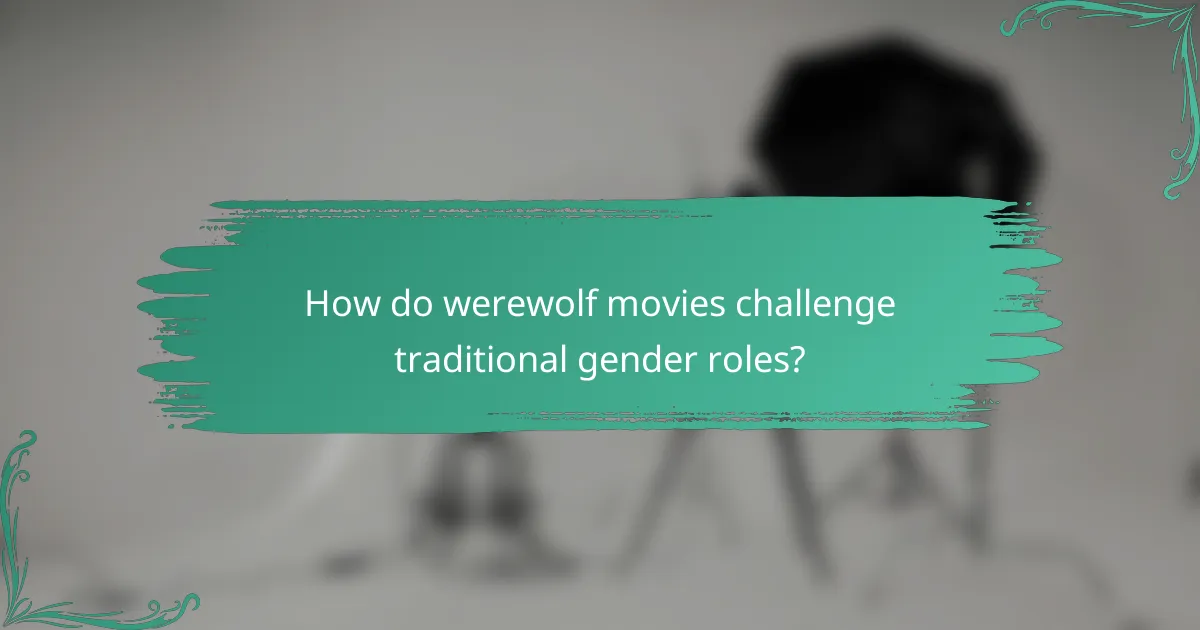
How do werewolf movies challenge traditional gender roles?
Werewolf movies often subvert traditional gender roles by presenting complex characters that defy societal expectations. These films explore themes of masculinity, femininity, and sexuality, allowing for a deeper examination of identity and power dynamics.
Subversion of masculinity in “An American Werewolf in London”
“An American Werewolf in London” challenges conventional masculinity by depicting the transformation of David into a werewolf as a loss of control and vulnerability. Instead of embodying the typical strong male hero, David experiences fear, confusion, and helplessness, which undermines traditional masculine ideals.
The film illustrates how societal pressures can distort male identity, as David grapples with his newfound instincts and the consequences of his transformation. This portrayal invites viewers to reconsider what it means to be masculine in a world where strength is often equated with aggression.
Empowerment of female characters in “Ginger Snaps”
“Ginger Snaps” features female characters who gain empowerment through their werewolf transformations, challenging gender stereotypes. The film centers on two sisters, Ginger and Brigitte, whose experiences with puberty and the werewolf curse serve as metaphors for female empowerment and rebellion against societal norms.
Ginger’s transformation is depicted as a journey of self-discovery, allowing her to embrace her sexuality and assert her independence. This narrative subverts the typical portrayal of women as passive victims, instead presenting them as active agents in their own stories.
Exploration of sexuality in “The Company of Wolves”
“The Company of Wolves” delves into the intersection of werewolf mythology and sexuality, using the werewolf as a symbol of repressed desires. The film portrays the transformation into a wolf as a metaphor for sexual awakening, challenging the notion of female sexuality as something to be feared or suppressed.
Through its dreamlike narrative, the film explores themes of seduction, danger, and the duality of human nature. This exploration encourages viewers to confront their own perceptions of sexuality and the societal constraints placed upon it, ultimately redefining the relationship between femininity and power.
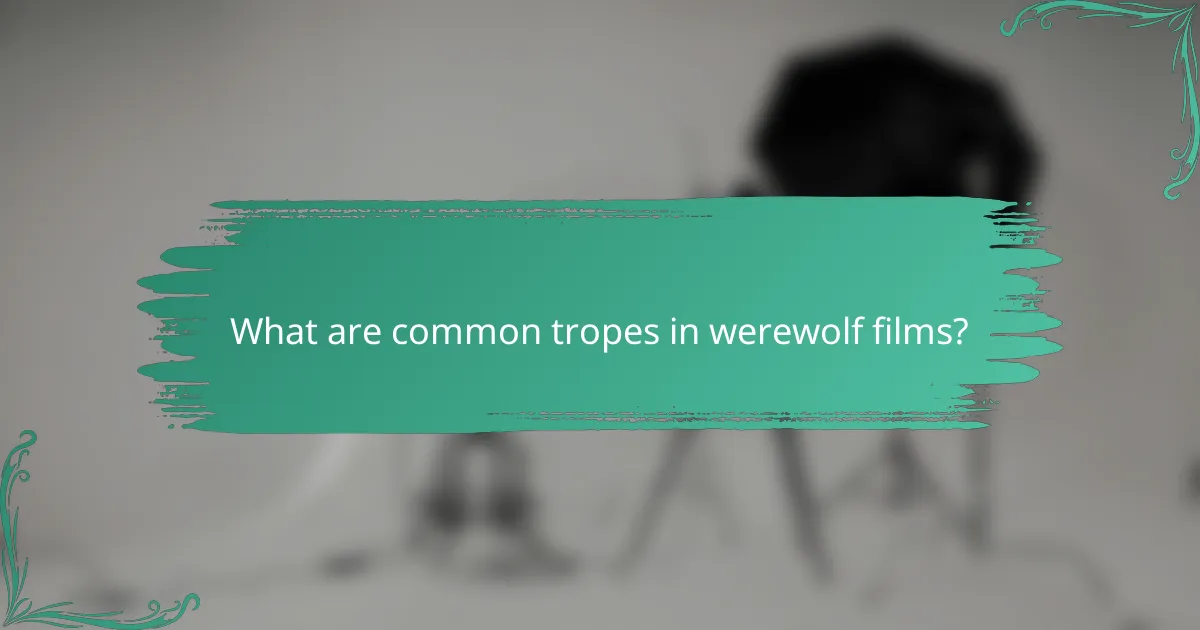
What are common tropes in werewolf films?
Common tropes in werewolf films often explore themes of transformation, isolation, and social dynamics. These films typically depict characters grappling with their dual nature, navigating societal expectations, and confronting their primal instincts.
Transformation as a metaphor for puberty
Transformation in werewolf films frequently symbolizes the tumultuous experience of puberty. Characters undergo physical and emotional changes that mirror the struggles of adolescence, highlighting the confusion and intensity of growing up.
This trope emphasizes the loss of control that often accompanies puberty, as characters transform into werewolves against their will. The struggle to manage newfound desires and instincts reflects the challenges faced during this critical life stage.
The lone wolf archetype
The lone wolf archetype represents characters who isolate themselves due to their werewolf nature, embodying themes of alienation and self-discovery. This trope often illustrates the internal conflict between the desire for companionship and the fear of harming others.
In many narratives, the lone wolf must confront their identity and the consequences of their actions. This journey often leads to a deeper understanding of themselves and their place in the world, challenging traditional notions of masculinity and independence.
Pack dynamics and social hierarchy
Pack dynamics in werewolf films reflect complex social hierarchies and relationships, often mirroring human societal structures. These films explore themes of loyalty, power struggles, and the importance of community, showcasing how characters navigate their roles within the pack.
Interactions within the pack can reveal underlying tensions, such as competition for dominance or the need for acceptance. This dynamic serves to challenge gender roles, as both male and female characters may exhibit traits traditionally associated with leadership or subservience.
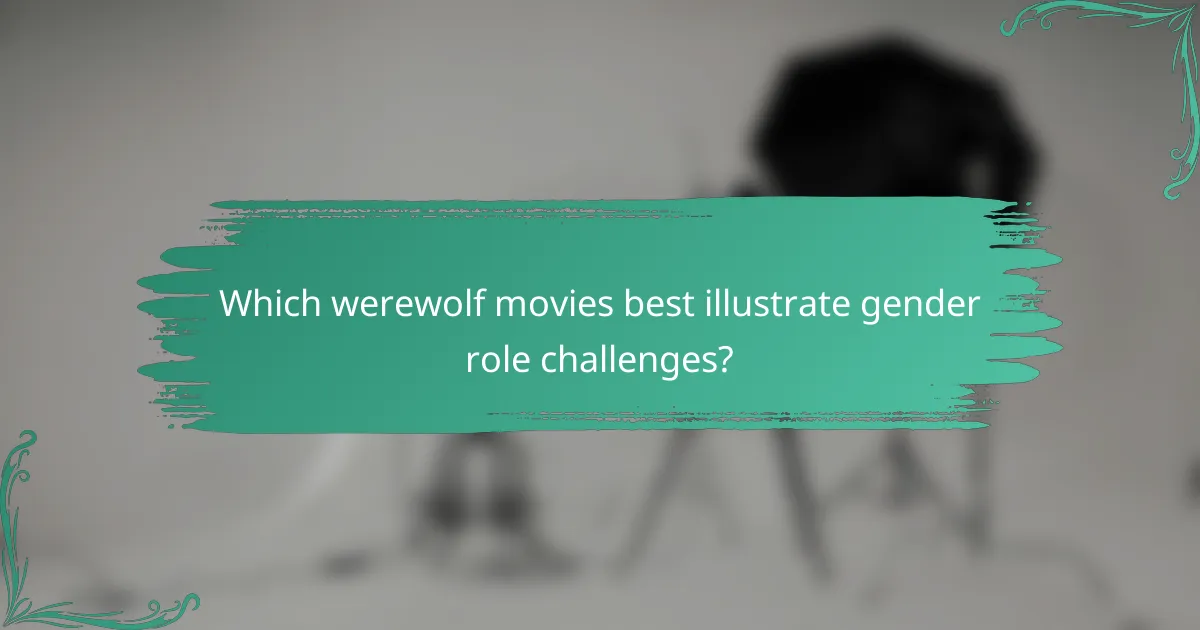
Which werewolf movies best illustrate gender role challenges?
Several werewolf movies effectively challenge traditional gender roles, showcasing themes of empowerment, feminism, and subverted masculinity. Notable examples include “Ginger Snaps,” “The Howling,” and “Dog Soldiers,” each offering unique perspectives on gender dynamics within the horror genre.
“Ginger Snaps” and female empowerment
“Ginger Snaps” centers on two sisters navigating adolescence and the societal pressures that come with it. The film uses the werewolf transformation as a metaphor for female empowerment, illustrating how the characters embrace their identities and challenge societal expectations.
The narrative highlights the bond between the sisters, showcasing their strength in confronting both external threats and internal struggles. This dynamic serves as a powerful commentary on female relationships and the journey toward self-acceptance.
“The Howling” and feminist themes
“The Howling” explores feminist themes through its portrayal of female characters who defy traditional roles. The film presents a female journalist who investigates a commune of werewolves, symbolizing the challenge against patriarchal structures and the reclaiming of female agency.
By placing a woman in a position of power and control, “The Howling” critiques the notion of women as mere victims in horror narratives. This shift encourages viewers to reconsider the representation of women in genre films.
“Dog Soldiers” and subverting masculinity
“Dog Soldiers” subverts traditional masculinity by placing a group of soldiers in a vulnerable position against werewolves. The film challenges the archetype of the invincible male hero, instead showcasing the fragility and fear experienced by the characters.
This portrayal encourages a reevaluation of male strength and vulnerability, emphasizing that masculinity can coexist with fear and emotional depth. The film’s approach invites discussions about the pressures placed on men to conform to rigid masculine ideals.
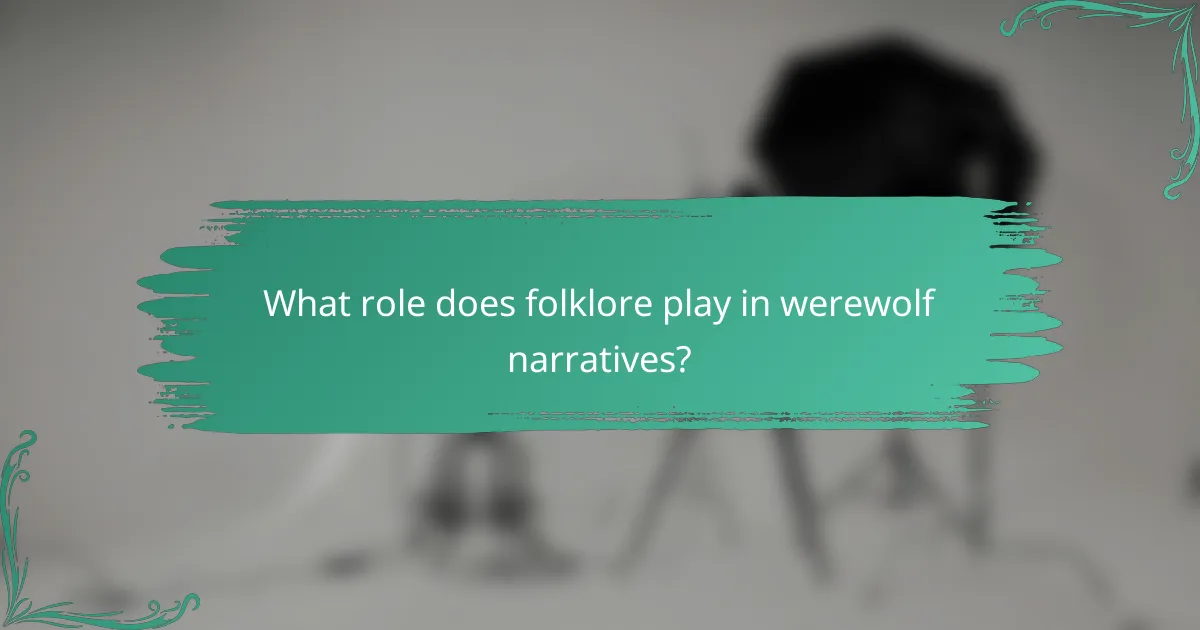
What role does folklore play in werewolf narratives?
Folklore serves as the foundation for werewolf narratives, shaping their themes, characters, and moral lessons. These stories often reflect societal fears and cultural values, particularly regarding transformation and the duality of human nature.
Historical context of werewolf myths
Werewolf myths date back to ancient civilizations, with roots in Greek and Roman mythology. In medieval Europe, tales of shapeshifting werewolves emerged, often linked to witchcraft and the supernatural. These narratives evolved over time, influenced by local customs and societal changes.
In many cultures, werewolves were seen as a representation of the struggle between civilization and primal instincts. This duality often mirrored societal concerns about morality, law, and the consequences of unchecked desires.
Gender implications in European folklore
Gender roles in European werewolf folklore frequently highlight the tension between masculinity and femininity. Male werewolves often embody aggression and violence, while female werewolves can represent seduction and danger, challenging traditional gender norms.
Stories featuring female werewolves may explore themes of empowerment and autonomy, as these characters often defy societal expectations. Conversely, male werewolves may symbolize the fear of losing control, reflecting anxieties about masculinity and societal responsibilities.
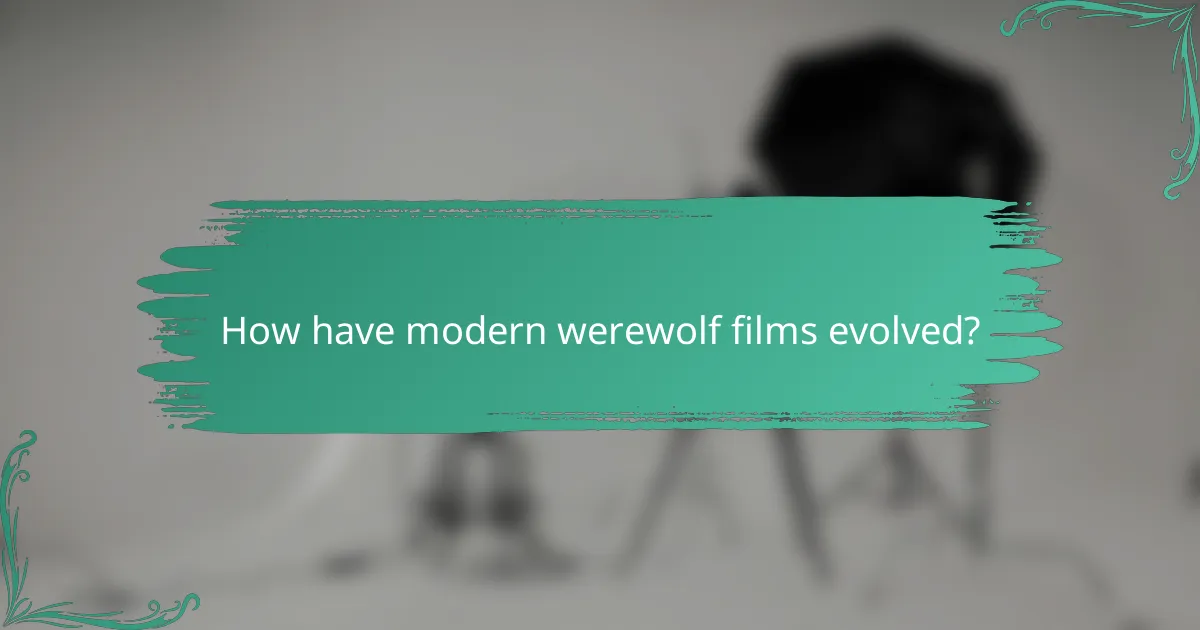
How have modern werewolf films evolved?
Modern werewolf films have evolved to challenge traditional gender roles and incorporate diverse themes, particularly focusing on identity and transformation. These films often explore deeper social issues, reflecting changing attitudes toward gender and sexuality.
Increased representation of [censured] themes
Recent werewolf films have increasingly included [censured] themes, portraying characters who grapple with their identities in relation to their transformations. This representation allows for a nuanced exploration of the fluidity of gender and sexuality, often paralleling the struggle of coming out or accepting one’s true self.
For instance, films like “The Howling” and “Ginger Snaps” showcase characters whose transformations serve as metaphors for the challenges faced by [censured] individuals. These narratives create a space for dialogue about acceptance and the complexities of identity.
Blending horror with social commentary
Modern werewolf films often blend horror elements with social commentary, using the werewolf mythos to critique societal norms. This approach allows filmmakers to address issues such as toxic masculinity, female empowerment, and the consequences of repression.
For example, “The Wolf of Snow Hollow” uses the werewolf as a symbol of unchecked aggression and societal expectations of masculinity. By intertwining horror with these themes, filmmakers encourage audiences to reflect on their own beliefs and behaviors regarding gender roles.
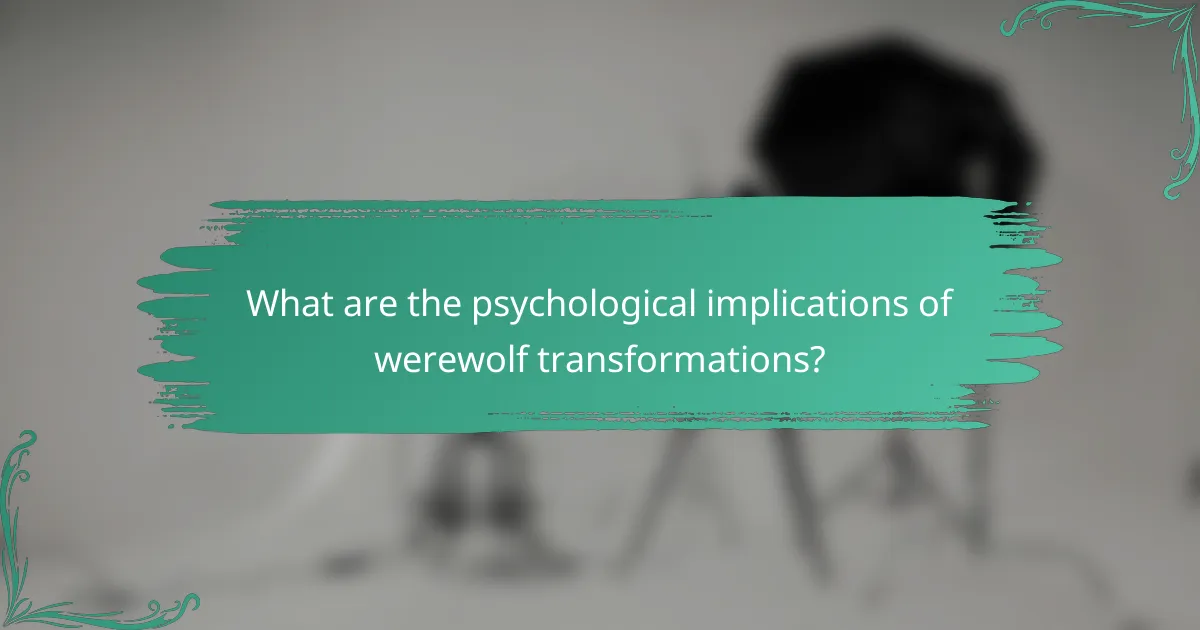
What are the psychological implications of werewolf transformations?
Werewolf transformations often symbolize the struggle between human nature and primal instincts, reflecting deep psychological conflicts. These transformations can represent repressed desires, aggression, and the loss of control, challenging traditional gender roles in the process.
Identity and Duality
The concept of identity in werewolf narratives highlights the duality of human nature. Characters often grapple with their animalistic side, representing a struggle between societal expectations and personal desires. This duality can challenge gender norms by showcasing how both men and women confront their inner beasts.
Repression and Release
Werewolf transformations frequently illustrate the consequences of repression. Characters may initially suppress their primal urges due to societal pressures, leading to explosive transformations that symbolize liberation. This release can serve as a critique of rigid gender roles that dictate acceptable behavior for men and women.
Violence and Power Dynamics
The violent nature of werewolf transformations often reflects underlying power dynamics in gender relations. The shift from human to beast can represent a reclaiming of power, particularly for female characters who may use their transformation to break free from patriarchal constraints. This dynamic invites viewers to reconsider traditional portrayals of masculinity and femininity.
